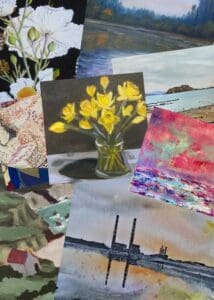Introduction:
Artistry often finds its grandeur in simplicity, and no genre of art exhibits this better than monochrome painting. Monochrome, or single-colour painting, is a powerful art technique that has influenced the art world for centuries. In this blog post, we’ll delve into the concept of monochrome painting, its significance, and how budding artists can create their own monochrome masterpieces.
Defining Monochrome Painting:
Monochrome painting, as the name suggests, involves the use of a single colour. It is not just an application of black and white or different shades of a single colour; instead, it can employ a wide range of tints, shades, and tones within one hue. Monochrome artwork often presents a stark, emotional impact that’s challenging to recreate with multicolour works. The magic lies in its subtlety and elegance, which invariably draw the viewer into a deep, introspective interaction with the art.
Monochrome in Historical Context:
Historically, monochrome paintings were prevalent in ancient or medieval religious art, predominantly to denote significance or symbolise various elements. As the art world evolved, artists began to realise the inherent power of monochrome painting to convey profound emotional depth and complexity. Renowned artists such as Yves Klein and Kazimir Malevich used monochrome techniques to create pieces that were pivotal in the abstract and minimalist movements.
How to Create a Monochrome Painting:
Creating a monochrome painting requires more than just an understanding of the basic concept. Here are some key steps you can follow to create your own monochrome masterpiece:
Choose your Colour:
Select a colour that resonates with your intent for the painting. The chosen hue should not just match your subject matter, but also the emotions you want your painting to evoke. For instance, blue might be an apt choice for a calming, serene composition, while red could be suitable for a piece depicting intense passion.
Prepare your Palette:
Once you’ve chosen your colour, prepare a palette with different tints, shades, and tones of that hue. To create tints, add white to your chosen colour. To make shades, add black. For tones, combine both white and black. This palette will provide the varying degrees of lightness and darkness you need for your painting.
Start Painting:
Begin your artwork with a basic sketch of your subject. Then, apply your different shades, tints, and tones to the sketch to give it depth and form. Keep in mind that your light source will affect where you place your darkest and lightest areas.
Finishing Touches:
Adding details is crucial in monochrome painting. Use your darkest shades for shadowed areas and your lightest tints for highlighted parts. This technique will enhance the overall depth and realism of your work.
Conclusion:
Monochrome painting is an engaging, expressive form of art that challenges the artist to make the most out of minimal resources. It strips art down to its most basic elements and asks the viewer to engage with the piece on a more intimate, emotional level. Whether you’re a seasoned artist or a novice looking to explore new techniques, monochrome painting offers a unique and rewarding artistic experience. Start your monochrome journey today and immerse yourself in the incredible world of single-colour paintings.
Disclaimer: The views and opinions expressed in this article do not necessarily reflect the official policy or position of Irish Artmart




